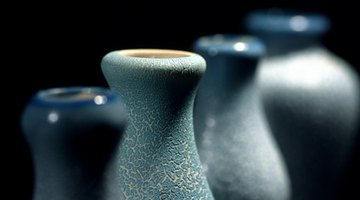Properties of Borax
Many of the properties of borax stem from its composition as a boron compound. Borax is a mineral and a salt of boric acid, and appears as a crystalline mineral in its natural form.

Boron is a metalloid chemical element with properties “intermediate between those of carbon and aluminum,” according to the University of California, Berkeley. Boron is extremely rare, but is found in borax and kenite.
General Properties
The chemical formula for borax, sodium borate, is B4-O7.2Na or Na2-B4-O7, according to Science Lab. Borax is a solid, odorless, weighs 201.22 g/mole and melts at 741 degrees Celsius. Borax is stable and non-corrosive in the presence of glass. It is incompatible with alkaloidol salts, mercuric chloride, zinc sulfate and other metallic salts, however, according to Science Lab. It is also incompatible with moisture. Borax is also referred to as boric acid, disodium salt, disodium tetraborate decahydrate, sodium borate, sodium borate decahydrate, sodium tetraborate and sodium tetraborate decahydrate. The mineral is white, gray, bluish or greenish-white streaked crystals, with a solubiity of 6g to 100g of water. Sodium borate has a density of 1.73, and a boiling point of 320 Celsius. The pH is alkaline.
Properties and Uses
Borax combines with cobalt, copper, chromium, manganese and nickel to form colorful compounds, according to the University of California. Because of this property, the mineral has been used as a pottery glaze since the Middle Ages. Borax is also a weak base and is used in photographic developers and buffer solutions. It is also an ingredient in everything from laundry detergent and household cleansers, to houseplant food and toothpaste for dogs. Due to its boron content, borax has a low chemical conductivity that increases substantially when heated. The boron behaves as a semiconductor, at some temperatures. It is also added to germanium and silicon to increase conductivity, according to the University of California.
Nutrition
Borax, as borate of sodium, is used as a homeopathic remedy by some for its boron content. The remedies, though not scientifically proven, include relief from gastro-intestinal irritation, excessive salivation and nausea. Boron may be nutritionally important, according to the University of California. It helps maintain the levels of hormones and minerals necessary for bone health. It is also important in the calcium cycle of plants and is frequently added to boron-poor soil as a fertilizer.
The Drip Cap
- Many of the properties of borax stem from its composition as a boron compound.
- Borax is stable and non-corrosive in the presence of glass.
- Borax combines with cobalt, copper, chromium, manganese and nickel to form colorful compounds, according to the University of California.
- Due to its boron content, borax has a low chemical conductivity that increases substantially when heated.
References
Writer Bio
Based in New York City, Sara Harvey has written about the environment, city planning, health and lifestyles since 1994. A former newspaper reporter, she now writes freelance full time. Her work has appeared in "Boho," a New York-based green fashion magazine, and several humor, parenting and business publications. Harvey has a bachelor's degree in print journalism.
Photo Credits
- pottery vase image by anh pham from Fotolia.com
- pottery vase image by anh pham from Fotolia.com
More Articles



